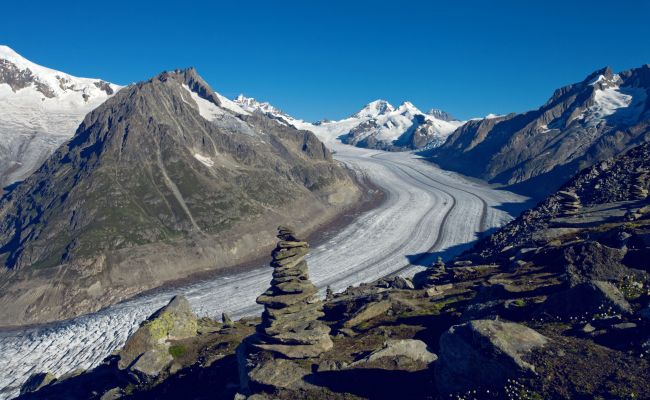The expansion of Jungfrau-AAletsch-BBietschhorn’s natural World Heritage property (originally inscribed in 2001) stretches the site to the east and west, increasing its surface area to 82,400 ha from 53,900 ha.
Global Importance and Ecological Processes
The site is world-renowned for its beauty and abundance of knowledge about mountain and glacier creation, as well as continuous climate change. It also highlights ecological and biological processes, such as plant succession, and has had a significant impact on European art, literature, mountaineering, and alpine tourism due to its breathtaking terrain.
Remarkable Universal Value
The Jungfrau-Aletsch-Bietschhorn region is the most glaciated area of the European Alps, with Europe’s largest glacier and unique glacial vistas. It gives a detailed overview of the geological processes that created the High Alps. The area supports a diversified flora and fauna in a variety of habitats, and the growth of plants following glacial retreat demonstrates plant succession.

Parameter
The Jungfrau-Aletsch-Bietschhorn region is world-renowned for its beautiful mountain landscape, which has influenced European art, literature, mountaineering, and travel. The area encompasses the magnificent north wall of the High Alps, dominated by the Eiger, Mönch, and Jungfrau summits, along with beautiful southern peaks and vast glaciers.
Geological and Geomorphological Features
Geological evidence suggests that the High Alps developed more than 20–40 million years ago. Furthermore, tectonic activity has thrust old crystalline rocks onto younger carbonate rocks, creating a landscape that spans from 809 to 4,274 meters in altitude. Furthermore, it has a number of geomorphological features, including U-shaped valleys, cirques, and the Aletsch Glacier, which are important for understanding glacial history and the effects of climate change.
Biodiversity and Habitats
This highlights the site’s distinct alpine and subalpine ecosystems on different rock substrates, as well as its biodiversity across altitudes and exposures. These habitats, particularly the distinctive Aletsch forest tree line, have survived with little human intervention, demonstrating climate change consequences like glacier retreat and the introduction of new plant species.
Sustainable Management and Governance
Strong legislative safeguards and a comprehensive management strategy developed through democratic processes contribute to the property’s effective management. Furthermore, the property emphasizes climate change mitigation, sustainable tourism management, and coordinated governance at the federal, cantonal, and local levels.
FAQ
The Aletsch Glacier is legally protected as part of the Jungfrau-Aletsch-Bietschhorn UNESCO World Heritage Site. Management techniques prioritize conservation efforts to counteract the effects of climate change and assure long-term preservation.
You can see the Aletsch Glacier from Jungfraujoch. You can reach Jungfraujoch, also known as the “Top of Europe,” by cogwheel train. The viewing platforms and observatories at Jungfraujoch provide panoramic views of the surrounding Alps, including the Aletsch Glacier.
